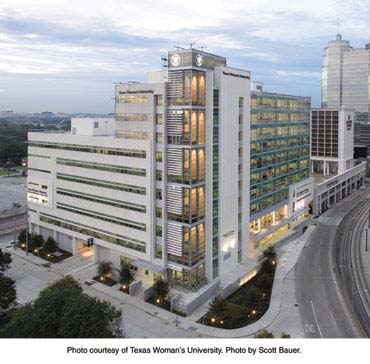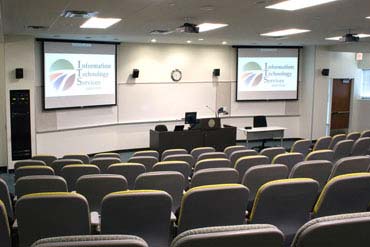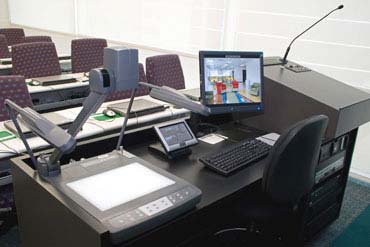Designing an Audiovisual System from the Ground Up
'Plan early, involve the faculty as much as possible, and research the trends and innovations'
Selecting audiovisual systems is seldom easy for higher education institutions. Determining who needs to do what, where they need to do it, how to make it happen, and how not to spend a fortune doing it require a lot of know-how and planning. Designing a brand new building in a different city complicates matters further. Yet a new build also brings opportunities to get the most out of the audiovisual systems.
Texas Woman's University (TWU) faced such challenges when the university decided to build a new Houston campus. TWU, the nation's largest university primarily for women, has campuses in Denton, Dallas and Houston. After 45 years at its previous Houston location, TWU planned for a new Institute of Health Sciences-Houston Center in the heart of Houston's world-renowned Texas Medical Center. The new building was a 10-story, 202,000 square-foot complete "campus in one building."

The TWU Institute of Health Sciences-Houston Center offers upper-level undergraduate programs in nursing and health studies and graduate programs in nursing, occupational therapy, physical therapy, health care administration, nutrition and the Executive MBA program.
Planning for the audiovisual portion began during the programming/design phase of the project, according to Bill Megee, instructional support services for TWU. The team was composed of AV and IT/telecommunications staff.
"As with all AV projects, our goals are to enhance teaching and learning in classrooms and labs, provide intuitive access to instructional technology, and do both cost effectively," said Megee. "In addition, we planned to further standardize classroom technology on the four TWU campuses."
The AV Infrastructure
As design moved into the construction plans, Megee said, they specified the infrastructure that would be required for the AV. Twelve months prior to the building's opening, they issued a request for proposals for an installed AV package. After evaluating proposals and interviewing candidates, the project went to Tampa, FL-based AVI-SPL.
"Our goal was to add the ability to present, communicate and teach within the campus and to other campuses," said Jeremy Blanton, AVI-SPL project manager. "Technology has become a critical piece of teaching the school's curriculum, so they wanted to ensure that the instructors had the latest technology to support the applications in the medical field."
Megee said the design was based on a functionality assessment on existing classroom/lab technology, current AV trends and innovations, and the perceived needs of faculty. AV would be used in the auditorium, lecture halls, classrooms, labs, and seminar rooms for presentation, teaching, and videoconferencing. There are two videoconferencing classrooms and two videoconferencing seminar/meeting rooms.

"Videoconferencing is used primarily for meetings and teaching from one TWU campus to the others in Dallas and Denton," he said. "Some faculty members are using the technology to conference with other schools or with guest lecturers."
TWU videoconference classes are all recorded using an IP-VCR. The recordings are distributed on DVD by request to students unable to attend the class.
TWU takes advantage of the benefits that networking offers AV systems. All classroom touch-panels are connected to the TWU LAN. All classroom systems are monitored and controlled over the network via IP using the AMX Resource Management Suite. Faculty contacts technical support using the touch panel, and the support staff responds via the touch-panel and performs classroom system diagnostics over the network.
Wireless networking also plays a role. "We have WiFi network access in the building for the university community," he said. "There are wireless touch panels in some classrooms, wireless microphones, wireless keyboards, and mice in many classrooms."
For growth, the building was constructed with two unfinished expansion floors. To date, one has been partially built out to expand space for student interaction and collaborative learning. Regarding AV systems, Megee explained the staff believes components will continue to shrink, thereby providing additional room for growth.
Megee is pleased with the results. "As a small university, with a centralized IT/AV division, and an effective vice president, we have been successful in our effort to standardize classroom technology on four campuses," he said. "The AV installation at the new Houston campus represented a milestone of that effort."
The base AV package cost $750,000 (including 4 percent contingency funding). The package provided instructional technology for an auditorium, lecture halls, classrooms, seminar rooms, a videoconference classroom and videoconference seminar rooms. Another $100,000 was added for instructional technology installed in 12 discipline-specific labs. Megee said that the building project, including the AV, was funded at no cost to the state of Texas through an innovative public/private partnership that has raised nearly $40 million to date.
AVI-SPL's Blanton said equipment included 35 AV systems, including three videoconferencing rooms (with advanced projection and audio systems) along with fully loaded equipment racks. There were 14 standard classroom packages, featuring customized instructor stations, dual projection systems, dual camera videoconferencing systems and advanced audio capabilities with voice uplift features. Twelve instructional labs were equipped with high-resolution projection systems, portable equipment racks with connectivity to DVD/VCR combo units, laptops and desktop computers.

One of the biggest challenges, said Megee, is that the AV design was not fully integrated into the building construction documents. At times, that made it difficult to coordinate the AV installation with the work of construction subcontractors.
Since the original AV install, TWU last year converted a standard classroom to a videoconference classroom to meet a growing demand for more off-site courses (although, he said, the trend is now moving toward more on-line courses). "Next year is the fourth-year scheduled upgrade of classroom technology for the Houston campus," said Megee. "At that time, we will evaluate classroom projectors, document cameras (ceiling versus tabletop), video players, etc. for upgrade/replacement, and also consider new components and capabilities to be implemented enterprise-wide."
His advice to others planning a new campus? "Plan early, involve the faculty as much as possible, and research the trends and innovations," he said. "Also, verify the project architect is contracted to provide an AV section in the construction plans and specifications, and make the electrical sub-contractor your new best friend."
He adds that TWU sees the trend in classroom technology moving from a fixed podium and fixed student seating to more portable interfaces and more flexible teaching spaces. "To that end, we are providing user-access to fewer components, and integrating more wireless devices into our classroom systems. At some point, we see the PC as the only source device in the room."
At the same time, he said, the needs don't change all that much over the years. "Faculty wants the same thing they wanted twenty-years ago: an overhead projector that works. So, keep it simple and reliable."
About the Author
Denise Harrison is a freelance writer and editor specializing in technology, specifically in audiovisual and presentation. She also works as a consultant for Second Life projects and is involved with nonprofits and education within the 3D realm. She can be reached here.